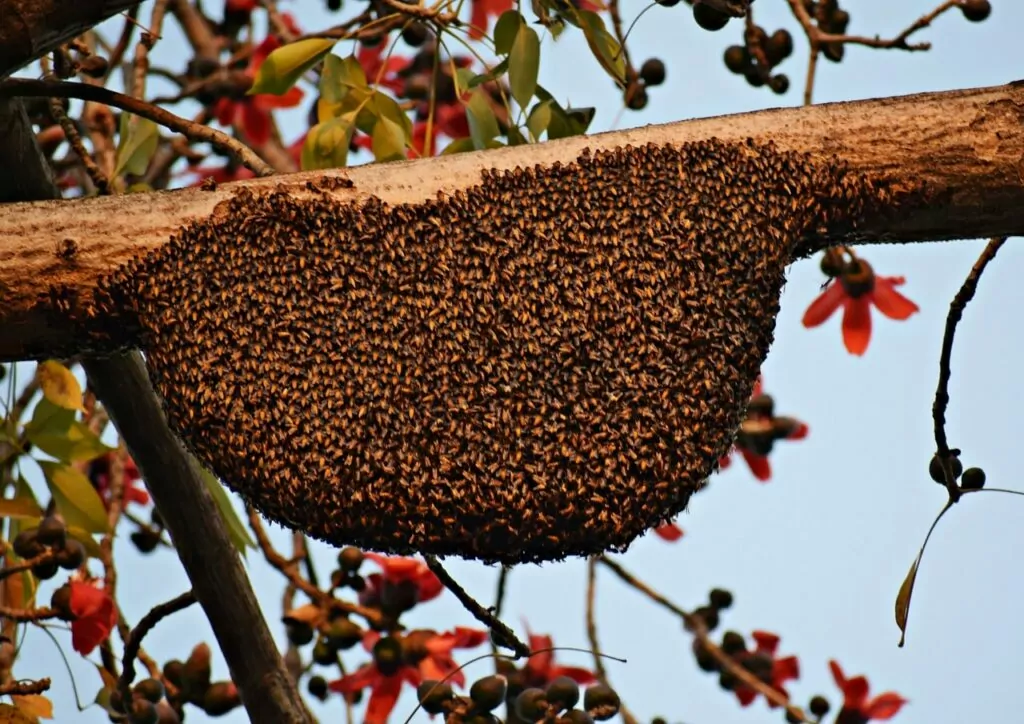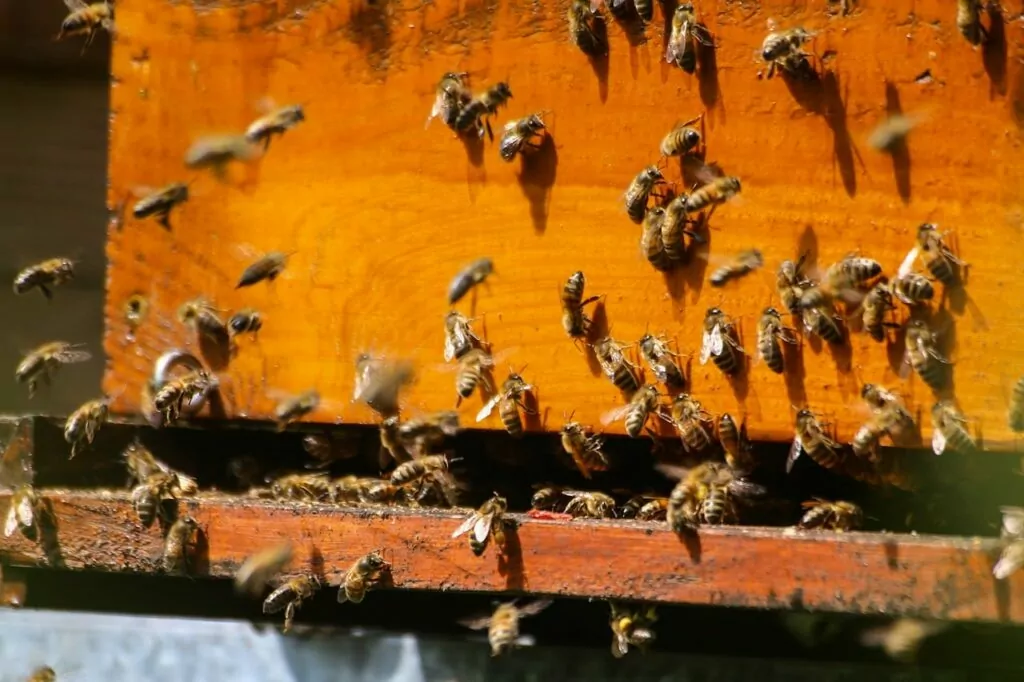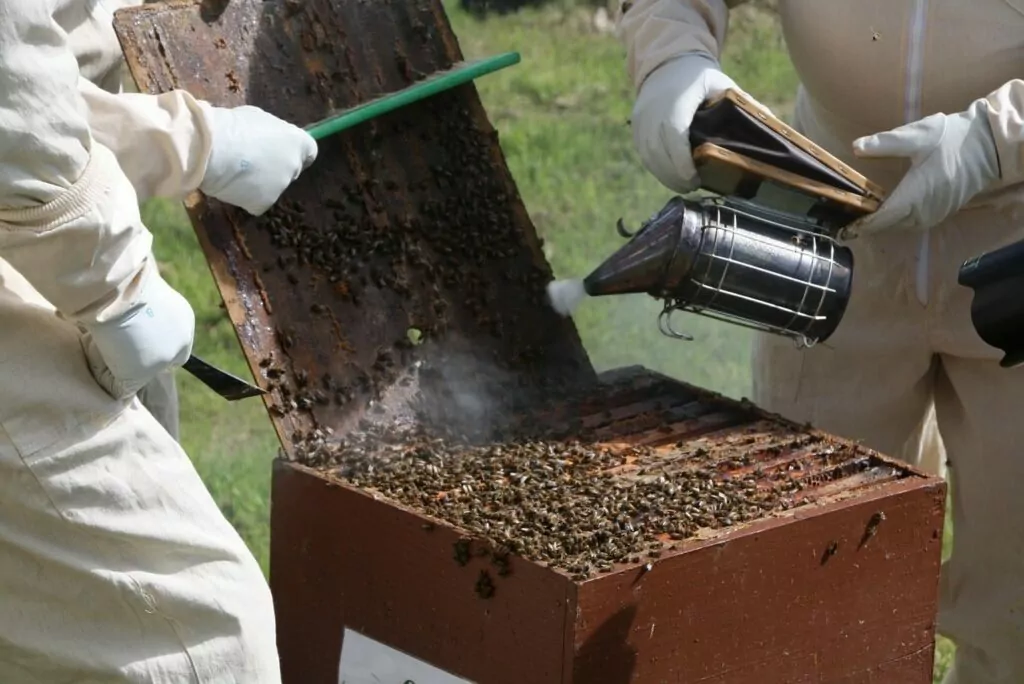The honey bee, though he may buzz around annoyingly or maybe even accidentally frighten you, should be protected at all costs.

Don’t swat at him, hit him, or spray him with nasty chemicals, he’s a good guy. He won’t hurt you with his big stinger unless he feels really threatened, and he’s not naturally vicious.
In fact, he’s on our side more than you will ever know.
If honey bees were to become extinct, the world as we know it would change forever. You could expect famine across nations. Wide-spread panic would ensue as all the food you’ve come to know and love would die off slowly.
They really do wonders for our world, the bees.
Of course, if you’re trying to attract honey bees, (see also: Are Honey Bees Attracted To Light?)you already know this!
And sunflowers are some of the best flowers for it. It’s very true, our pollinators love sunflowers. Only, the different varieties aren’t all the same.
You’ll want to be sure that you are planting sunflowers that are going to be beneficial for the bees.
In this article, we’ll take a look at the best sunflower species to transform your back garden into a beautiful and buzzing bee paradise.
The Best Sunflower Species To Attract Honey Bees
If you want to help the bees out, the best thing you can do is entice them into your garden with big beautiful flowers.
Just be sure to check with your seed supplier that they’re definitely not pollenless. The bees won’t want that.
Then keep in mind the space in which you have. If you’ve got lots of space there is no need to overcrowd, you can spread your pollen plants far and wide to allow for a more diverse space. I would recommend planting bee trees if you’ve got the extra space too.
If you’re working with a small area of space, don’t despair, simply plant what you can. Some pollinating sunflowers are better than nothing at all. Every little, and every plant, helps!
1. Lemon Queen
If you’re new to gardening, Lemon Queen is a great sunflower to grow. It’s really easy to manage, the blooms are in a small to medium size, and can stand pretty dry conditions.
But you’ll also be super proud of your plant, it reaches heights of up to 7 ½ feet, and has these lovely bright lemon-yellow petals. Birds, bees, and butterflies are sure to be regular visitors to your garden with this species of sunflower.
2. Mammoth Grey Stripe
If you want sunflowers that no animal will ever be able to miss, then Mammoth Grey Stripe is the species for you.
These magnificent beasts can grow upwards of 12 feet and have these huge flowers that will call out to the bees like a lighthouse to a ship.
Any pollinator is sure to make their way to your garden with these sunflowers.
3. Vanilla Ice
For those with minimal space, don’t worry, you can still plant sunflower seeds. They don’t all have to reach great heights. This species of sunflower reaches no more than 4 feet tall and has fairly small, creamy white flowers.
One of the best things about Vanilla Ice is that they flower for an incredible amount of time, even if they do require quite a lot of watering.
4. Black Russian
Black Russian sunflowers are a wonder to behold but require a fair amount of care to maintain. These enormous flowers are sure to tower over all else as they grow up to a whipping 15 feet in height.
The flower itself is also very large with an 8” diameter. It is sure to provide for all pollinators and even create some tasty seed snacks for the birds.
5. Giant White Seeded
Giant, indeed. If you thought the Black Russian was big, meet its even larger counterpart the Giant White Seeded.
This sunflower soars to heights of 14 feet while its flower can open wide and stretch out as far as 19 inches in diameter.
Imagine, a large dinner plate, and you’ll be at around the right size. They also have these unique white-looking seeds which give the flower its name.
6. Dwarf Yellow Spray
If you only really have space for fairly short and dinky flowers, then the Dwarf Yellow Spray Sunflowers are the perfect option. You won’t have trouble with them growing too tall since they only reach a maximum height of 2 feet.
Though their spread is around 17 inches. They are by nature easy to grow and produce a stunningly bright bloom that no bee could ever resist.
7. Henry Wilde
Henry Wilde variations are the classic flowers that you probably picture when you hear the name sunflower. They have those bright bold yellow petals with that deep and dark seedy center.
Once the bees have got their fill of these flowers, feel free to cut some and add a pop of color to your home. This is the perfect variety for it.
8. Autumn Beauty
These sunflowers are probably unlike anything you’ve ever seen before. They are the perfect addition to any green space because not only are they a perfect option for our honey bees and other pollinators, but they are drop-dead gorgeous.
They use a variety of shades from yellows, mahoganies, reds, and oranges to attract our buzzing besties, but it also helps us that they look like a sunset.
9. Chocolate Cherry
Chocolate Cherry sunflowers don’t have that striking yellow color you may be accustomed to. Instead, the petals are more of a burgundy color and the seeds are a rich deep chocolate brown.
They make amazing border flowers and, of course, are perfect pollinators. They also have a super long vase life, so be sure to cut some to keep the inside of your home as stunning as the outside.
10. Evening Sun
As the name suggests, this species of sunflower will also remind you of the evening sun as it sets behind the horizon.
And it is not only humans that can’t get enough, you’ll find that bees, birds, and butterflies will be frequent visitors with these flowers in your garden.
Plus, they’re deer resistant which could be a pretty important factor depending on where you are planting.
11. Earth Walker
This is a great option for novice gardeners. It can grow in pretty much any soil type, and as long as it’s watered and gets access to plenty of sunlight, it’s almost impossible to go wrong.
It grows to around 6 feet, so you’ll have an impressive flower that is sure to attract all the honey bees (see also: Best Flowers To Attract Bees)around with its vibrant pop of colors.
12. Sonja
Not everyone has big gardens or even gardens at all, and that’s okay. Even urban balconies and small patios can be used to provide that much-needed pollen to our honey bees.
And with sunflower species such as Sonja, there’s no excuse not to. They grow to just 3 feet in height and only have 4-6 inch diameter flowers.
They definitely don’t have as much pollen as some other species of its kind, but in limited space, it’s still better than nothing. By a long mile.
13. Teddy Bear Sungold
Just like teddy bears, these unique sunflowers are super fluffy-looking. They genuinely look like giant yellow puffballs. So, if you want to opt for a really unique sunflower, this is definitely an option.
They grow really quickly and are drought-resistant, and honey bees can’t help themselves when they see them.
14. Red Sun
As you can imagine from a sunflower variety named red sun, these flowers bloom with the most strikingly beautiful red petals.
This might not seem like the best option since bees actually have trouble seeing the color red, but the pollen will still draw them in.
These flowers just won’t stand out to the honey bees quite as much as they do to us.
15. Maximillian
Maximillian sunflowers are a great planting option because they flower during the late summer or early fall. This means that they provide a really valuable food source for the honey bees at a point where finding food is tough.
Just be sure to make sure you have enough space for them as they can grow upwards of 10 feet and tend to self-seed producing quite the colony of sunflowers.
16. Pastiche
Pastiche sunflowers are very persistent, it takes a lot for them to wither which is perfect as it means they are an almost-constant source of food for the honey bees.
They are relatively easy to grow and they produce these really pretty petals which feature several different hues of yellow, red, and purple.
17. Velvet Queen
When grown in well-drained, rich soil, and subjected to several sunny days, this variety of sunflowers can grow up to seven feet in height.
They are a little more particular and difficult to grow so I wouldn’t recommend them to someone new to the gardening scene.
They produce stunning mahogany petals and the flowers are around 4 inches in diameter.
Usually, you’ll get around a 100-day pollen supply too.
18. Titan
If you’ve got plenty of space and are in a bigger the better mindset, then you won’t find a better sunflower species than Titan. These huge flowers can grow as high as twelve feet upwards and 24 inches across.
A plantation of these stunning sunflowers would have the ability to keep multiple hives busy for months on end. They also come jam-packed full of seeds so they’ll provide a healthy snack for the local bird life too.
Frequently Asked Questions
No. It’s really important that you check the type of sunflowers you’re getting before you purchase them.
Many varieties are pollenless, and while this is great for allergy sufferers and tidy gardens, they are nowhere near as beneficial to bees as the pollen-heavy options.
If you suffer from an allergy or for any other reason simply cannot produce sunflowers with plenty of pollen, planting pollenless sunflowers will still have some benefits.
They still provide honey bees with nectar so there is some sustenance in them, just not as much as the pollen-heavy counterparts.
Yes! Incredibly so. Sunflowers are a really great source of food for these pollinators. And studies have actually shown evidence of sunflowers being used to help boost the immune system of sick and poorly bees.
Yes! There are many ways that sunflowers attract honey bees. First of all, they tend to soar high above any other plants making themselves easily detectable.
And then thanks to their bright colors, they are even more alluring to the honey bee. Just remember that bees can’t see the color red amazingly well, so red sunflowers will attract fewer honey bees.
Final Thoughts
We really should be kinder to our bees. They do a lot for us. In fact, they help our food and veggies grow, so the least we can do is return the favor.
And there’s no better meal for a honey bee (see also: Picking The Best Clover For Honey Bees; Best Species Of Clover)than a sunflower packed full of nectar and pollen.
So, I really do encourage you to grow as many sunflowers as possible in your given space. Now, for some, this might mean opting for the smaller dwarf varieties while for others they may go for the giants and titans.
But whether you grow sunflowers great or small, I can be sure of one thing, the honey bees will thank you for your efforts.
- Does Borax Kill Bees? - May 7, 2024
- Will Robber Bees Kill the Queen? & How to Prevent This? - April 30, 2024
- Does Bleach Kill Bees? - April 23, 2024




